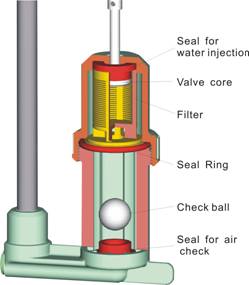水生生態系における濁度と水温の関係
Table of Contents
水温と濁度は、水生生態系の健全性と安定性に重要な役割を果たす 2 つの重要な要素です。濁度は浮遊粒子によって引き起こされる流体の濁りまたは曇りを指し、水温は水の暖かさまたは冷たさの尺度です。これら 2 つの要因は密接に関連しており、水生生態系の全体的な健全性に直接影響を与える可能性があります。
濁度は、いくつかの方法で水温に影響を与える可能性があります。最も重要な方法の 1 つは、太陽光の吸収と反射によるものです。水が濁ると、水中の浮遊粒子が太陽光を吸収し、水温の上昇を引き起こす可能性があります。これは水全体の温度に直接影響を与える可能性があり、ひいては生態系に生息する生物に影響を与える可能性があります。
さらに、濁りは水に浸透する太陽光の量を減少させることによって水温にも影響を与える可能性があります。水が濁ると、水柱の底に届く太陽光が少なくなり、水温が低下する可能性があります。一部の種は暖かい水温を好む一方、他の種は低い水温を好むため、これは生態系内の生物の分布に直接影響を与える可能性があります。
濁度と水温の関係は複雑で、生物の固有の特性に応じて変化する可能性があります。水生生態系。場合によっては、濁度が水に吸収される太陽光の量を増やすことにより、水温にプラスの影響を与える可能性があります。他の場合には、濁度が水に浸透する太陽光の量を減少させることにより、水温に悪影響を与える可能性があります。
濁度と水温の関係は必ずしも単純ではないことに注意することが重要です。深さ、流量、周囲の土地利用などの他の要因も、水生生態系の水温の決定に役割を果たす可能性があります。たとえば、浅くて流れの遅い水は濁りによって水温が変動しやすい可能性がありますが、深くて流れの速い水はより安定している可能性があります。
濁度は水温に影響を与えるだけでなく、他の影響も与える可能性があります。水生生態系。濁度が高くなると、光合成に利用できる光の量が減少し、水生植物や藻類の成長に影響を与える可能性があります。多くの生物が食物と生息地を植物や藻類に依存しているため、これは生態系全体に連鎖的な影響を与える可能性があります。
全体的に、水生生態系における濁度と水温の関係は複雑かつ多面的です。濁度は太陽光の吸収と反射を通じて水温に直接影響を与える可能性がありますが、他の要因も水生生態系の水温の決定に役割を果たします。濁度と水温の関係を理解することは、将来の世代のために水生生態系を管理し保護するために不可欠です。

濁度が自然水域および人工水域の水温に与える影響
濁度、または一般に肉眼では見えない多数の個々の粒子によって引き起こされる流体の濁りまたは曇りは、水域の一般的な特徴です。これは、土砂の流出、藻類の繁殖、産業汚染など、さまざまな要因によって引き起こされる可能性があります。濁度は水質や透明度と関連付けられることが多いですが、水温への影響は水生生態系に重大な影響を与える可能性があることはあまり知られていません。
川、湖、海洋などの自然水域では、濁度が影響を与える可能性があります。いくつかの方法で水温に影響を与えます。最も直接的な方法の 1 つは、太陽光の吸収と散乱によるものです。水が濁ると、水柱内の浮遊粒子が太陽光を吸収して散乱し、水に浸透する光の量が減少します。これは、水を加熱するために利用できる太陽光が少なくなるため、水温の低下につながる可能性があります。
さらに、濁度は水柱内の熱の分布に影響を与えるため、水温に影響を与える可能性があります。透明な水では、太陽光が水の奥まで浸透し、表層をより効果的に加熱します。これにより、地表ではより暖かい水が、深部ではより冷たい水が存在する、層状の温度プロファイルが作成されます。しかし、濁った水では、太陽光は表面近くで散乱および吸収され、水柱全体に熱がより均一に分布します。これにより、澄んだ水と比較して、表面温度が低くなり、深部の温度が高くなる可能性があります。
貯水池や池などの人工の水域では、濁度も水温に影響を与える可能性があります。これが起こる主な方法の 1 つは、ダムの建設と運用です。ダムは水の流れを変え、堆積物を捕らえ、さまざまなレベルの濁度を持つ貯水池を作り出すことができます。このような環境では、濁度が水層の混合に影響を及ぼし、水温に影響を与える可能性があります。たとえば、濁度の高い貯水池では、太陽光が水のより深い層に到達することが妨げられ、深部の温度が低下する可能性があります。
さらに、人工の水域に濁りが存在すると、水温が変化し、水温に影響を与える可能性があります。水生生物の生息地。多くの水生種は水温の変化に敏感であり、濁りによって周囲の地域よりも暖かい、または寒い微気候が生じる可能性があります。これは、種の分布と存在量、さらには成長と繁殖率に影響を与える可能性があります。
全体的に、濁度と水温の関係は複雑かつ多面的です。濁度は太陽光の吸収と散乱を通じて水温に直接影響を与える可能性がありますが、水柱内の熱分布に影響を与え、水生生物の生息環境を変えることによって水温にも影響を与える可能性があります。水温の変化はこれらの環境の健全性と安定性に広範な影響を与える可能性があるため、これらの相互作用を理解することは、水生生態系を管理および保護するために極めて重要です。水温の形成における濁度の役割を考慮することで、研究者や政策立案者は水資源の保全と回復のためのより効果的な戦略を立てることができます。
Turbidity, or the cloudiness or haziness of a fluid caused by large numbers of individual particles that are generally invisible to the naked eye, is a common characteristic of water bodies. It can be caused by a variety of factors, including sediment runoff, algal blooms, and industrial pollution. While turbidity is often associated with water quality and clarity, its impact on water temperature is a lesser-known aspect that can have significant implications for aquatic ecosystems.
In natural bodies of water, such as rivers, lakes, and oceans, turbidity can affect water temperature in several ways. One of the most direct ways is through the absorption and scattering of sunlight. When water is turbid, suspended particles in the water column can absorb and scatter sunlight, reducing the amount of light that penetrates the water. This can lead to a decrease in water temperature, as less sunlight is available to heat the water.
Additionally, turbidity can impact water temperature by affecting the distribution of heat within the water column. In clear water, sunlight can penetrate deeper into the water, heating the surface layers more effectively. This creates a stratified temperature profile, with warmer water at the surface and cooler water at depth. In turbid water, however, sunlight is scattered and absorbed near the surface, leading to a more uniform distribution of heat throughout the water column. This can result in lower surface temperatures and higher temperatures at depth compared to clear water.
In man-made bodies of water, such as reservoirs and ponds, turbidity can also influence water temperature. One of the primary ways this occurs is through the construction and operation of dams. Dams can alter the flow of water, trap sediment, and create reservoirs with varying levels of turbidity. In these environments, turbidity can impact water temperature by affecting the mixing of water layers. In highly turbid reservoirs, for example, sunlight may be blocked from reaching the deeper layers of water, leading to cooler temperatures at depth.
Furthermore, the presence of turbidity in man-made bodies of water can also influence water temperature by altering the habitat for aquatic organisms. Many aquatic species are sensitive to changes in water temperature, and turbidity can create microclimates that are either warmer or cooler than surrounding areas. This can impact the distribution and abundance of species, as well as their growth and reproduction rates.
Overall, the relationship between turbidity and water temperature is complex and multifaceted. While turbidity can have a direct impact on water temperature through the absorption and scattering of sunlight, it can also influence temperature by affecting the distribution of heat within the water column and altering the habitat for aquatic organisms. Understanding these interactions is crucial for managing and protecting aquatic ecosystems, as changes in water temperature can have far-reaching effects on the health and stability of these environments. By considering the role of turbidity in shaping water temperature, researchers and policymakers can develop more effective strategies for conserving and restoring our water resources.







